A History of the County of Surrey: Volume 3. Originally published by Victoria County History, London, 1911.
This free content was digitised by double rekeying. All rights reserved.
'Parishes: Burstow', in A History of the County of Surrey: Volume 3, ed. H E Malden (London, 1911), British History Online https://prod.british-history.ac.uk/vch/surrey/vol3/pp176-182 [accessed 1 February 2025].
'Parishes: Burstow', in A History of the County of Surrey: Volume 3. Edited by H E Malden (London, 1911), British History Online, accessed February 1, 2025, https://prod.british-history.ac.uk/vch/surrey/vol3/pp176-182.
"Parishes: Burstow". A History of the County of Surrey: Volume 3. Ed. H E Malden (London, 1911), British History Online. Web. 1 February 2025. https://prod.british-history.ac.uk/vch/surrey/vol3/pp176-182.
In this section
BURSTOW
Burstowe and Burghstowe (xiv cent.); Byrstowe (xv cent.); Bristowe (xvii cent.).
Burstow is a country parish on the Sussex border. The church is 7 miles south-east of Reigate, and about 2 miles south-south-east of Horley Junction. It is bounded on the north and east by Blechingley, on the east by Horne, on the south by the county of Sussex, on the west by Horley, a detached part of Horne, and Nutfield. It measures about 6 miles from north to south, and is about 1 mile broad at the north and 2 miles at the southern part. It contains 4,750 acres. The soil is the Wealden Clay over most of the parish, but in the south-east where the ground rises to Copthorne Common it is Hastings Sand. Across the northern part of the parish a ridge of higher land runs from east to west, formed by a bed of Paludina Limestone. It yields stone, usually called Sussex marble, which is susceptible of polish; but, as is generally the case in the Surrey examples of this stone, it is too friable for architectural work. The parish as a whole is a typical Wealden parish, formerly thickly wooded with oak, which furnished the massive framework and rafters of the farms; in the absence of building stone the houses were probably all oak-framed. The upper waters of the Mole drain Burstow, but on the eastern side the streams and ditches communicate with the upper Medway. No main road or railway is actually in the parish, for the main Brighton line and road pass to the west of it, the South Eastern line to the north of it. It is purely agricultural, with a few brickfields. Copthorne Common is now inclosed in Burstow, though part of the common across the Sussex border in Worth parish is still open. Part of it is called Effingham Park, from an Effingham on the county border, but this has no connexion with the village of Effingham in Surrey. There is some open ground at Outwood Common. The village is not at all compact; there are a few houses near the church, others are about Copthorne or Smallfield, or are scattered farms. The parish was formerly one of the seats of the iron industry in the Weald, which flourished about Copthorne, (fn. 1) though no forge or furnace of importance in the 16th-century lists can be located exactly in Burstow parish. The name Blacksmith's Farm probably refers to a forge, and ornamental iron fire-dogs, fire-backs, &c., were till recently common in the farms and cottages.
There seem to be no records of prehistoric antiquities, though it is unlikely that such should not be found about the higher and drier soil of Copthorne; but this part of Surrey has been much less thoroughly explored, archaeologically, than the west and north.
The antiquarian feature of the parish is the comparatively large number of moated houses. Many of the older houses possessed this characteristic feature, as the abundance of water, and the retentive nature of the clay soil, made moats the natural defence; the moats remain in whole or in part around several of them. Burstow Lodge is moated. On the west of Smallfield Place there appear to be the remains of a moat. Rede Hall is situated in the middle of a very large moated inclosure; the old house has been lately rebuilt. Court Lodge Farm, just north of Burstow Church, shows traces of an extensive moat, and south of the church is a moated inclosure in which there is now no house, but which is probably the site of the old manor-house of Burstow Court, taken down in 1786. (fn. 2) Burstow Hall is the seat of Mr. D. M. Jackson; Smallfield Place of Mr. W. Leslie Moore; Burstow Lodge of Mr. Lord John Sanger, the well-known owner of wild beasts; The Gables, where there is a preparatory school, of Mr. E. C. Marsh. About Copthorne and Effingham a considerable number of modern houses have been built.
There was an Inclosure Award, 15 August 1855, (fn. 3) inclosing waste at Copthorne and Burstow Common Fields. It is interesting as one of the rare appearances of any common fields in the Weald, and it may be noted that they were on a manor which was from its earliest mention attached to a manor (Wimbledon) in the old settled part of the county.
There are Baptist chapels at Burstow and at Fernhill, and a mission room near Smallfield.
The school at Smallfield was built as a Church school in 1859, and added to in 1861. A School Board was formed, which took it over in 1874.
Outwood is an ecclesiastical district formed from the parishes of Blechingley, Burstow, Horley, Horne, and Nutfield (19 August 1870). The church is in Burstow parish, and the northern part of Burstow parish is included in the district.
The church (St. John the Baptist) was built in 1869. It is of stone in 13th-century style, with a tower. There is also a Baptist chapel built in 1879. The school, built in 1876, was under the Burstow School Board. Brightleigh is the seat of Miss Collingwood; Ashcroft of Mr. W. H. Maw; Axeland Park of Mr. D. Wardlaw Wardlaw. Abbot's Hospital, Guildford, has land in Outwood.
MANORS
No mention of Burstow occurs in the Domesday Survey, (fn. 4) but the manor appears to have been held as early as the reign of Richard I by a family who took their name from the land. Sir Edward Bysshe, a descendant of this family, (fn. 5) writing from the evidence of documents and seals in his possession, states that Stephen de Burstow, whose name appears in the seals as Stephen Fitz Hamo, held the manor in the latter part of the 12th century, and that he was succeeded by his son Roger and his grandson John, the latter holding during and prior to the reign of Henry III. (fn. 6) Of John de Burstow there are other records. He made a grant of lands in Burstow about the year 1205. (fn. 7) In 1210–12 John de Burstow held half a knight's fee 'in Wimbledune' of the Archbishop of Canterbury. (fn. 8) This entry seems to refer to the service rendered for the manor of Burstow, which was held of the archbishop as of his manor of Wimbledon. (fn. 9) In 1247 a John de Burstow was lord of the manor, (fn. 10) though whether this is the John mentioned above or the son of the same name who, according to Bysshe, succeeded his father, is not evident. In 1255 a settlement was made between John de Burstow and Peter de Burstow, possibly a younger brother, by which John was to hold the manor, paying an annual rent of 4 marks to Peter, John and his heirs to be quit of payment on Peter's death. (fn. 11) From the account of this family given by Bysshe it appears that the second John married Joan Burnevalle and had a son Roger, (fn. 12) who married Matilda Chastillon and was succeeded by his son John, who served in the French wars under the Black Prince and won great distinction. (fn. 13) The next records of the manor, in 1350 and 1358, show it to have been held at that time by Richard de Burstow, (fn. 14) whose name, however, does not appear in Bysshe's pedigree, and whose relationship to John de Burstow is not apparent.
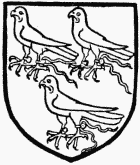
Burstow. Gules three falcons close argent.
In 1366 the reversion of the manor was conveyed by Richard de Burstow to Sir Nicholas de Loveyne. (fn. 15) Margaret daughter of Nicholas Loveyne married Sir Philip St. Clere, and they held the manor in the right of Margaret, who was her father's heir. (fn. 16) When Sir Philip St. Clere died in 1408, very shortly after his wife, he was holding the manor of Burstow 'of the Archbishop of Canterbury by paying £6 yearly at his manor of Wimbledon.' (fn. 17) John St. Clere, son and heir of Philip, died in 1418, and was succeeded by his brother Thomas. (fn. 18) In 1424–5 Thomas St. Clere, whose children were then all minors, granted the manor to William Cheyne, kt., John Aston, and Geoffrey Motte, in trust for himself and his heirs, 'in order to defraud the king and other lords of those fees (i.e. the manor of Burstow and others) of the custody thereof and the marriages of the heirs.' (fn. 19) Aston's share was afterwards conveyed to John Hall, (fn. 20) while Geoffrey Motte remitted his to the other trustees. (fn. 21) Thomas St. Clere died in 1435, leaving three daughters and no sons. (fn. 22) The second daughter, Eleanor, inherited the manor of Burstow; she married John Gage, who was seised of it at his death in 1475, when, his wife having predeceased him, their son William became lord of the manor. (fn. 23) John Gage, who was the son and heir of William and who was afterwards knighted, succeeded to the manor at the death of his mother Agnes, on whom it had been settled by her husband. (fn. 24) The manor descended from Sir John to his son Sir Edward Gage, who as Sheriff of Surrey and Sussex, 1557–8, was concerned in the Marian persecutions. He died in 1568. (fn. 25) His son John married Margaret daughter of Sir Thomas Copley, of the noted recusant family, and died without issue, his heir being his nephew John Gage, who in 1614 conveyed the manor to Sir Edward Culpepper (fn. 26) of Wakehurst. (fn. 27) He died in 1630, when his eldest surviving son, Sir William Culpepper, created a baronet in 1628, (fn. 28) inherited the manor. (fn. 29) Another son Edward seems to have held some share in the manor, settled on him doubtless on his marriage with Mary Bellingham; (fn. 30) in 1638 he was apparently lord of the manor, (fn. 31) but it certainly reverted afterwards to the elder branch, and in 1696 Sir William Culpepper, fourth baronet, sold it to Sir Richard Raines, (fn. 32) LL.D., judge of the Prerogative Court of Canterbury.
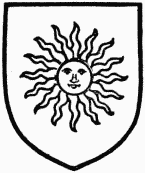
St. Clere. Azure the sun in splendour or.
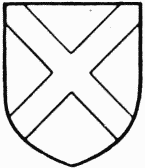
Gage. Party saltirewise azure and argent a saltire gules.
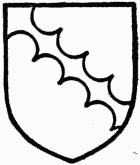
Culpepper. Argent a bend engrailed gules.
Henry Raines, son of Richard, inherited the manor at his father's death, (fn. 33) and in 1733 conveyed it to Joseph Kirke, (fn. 34) to whom Raines's widow Susan quitclaimed her right in 1745. (fn. 35) Kirke, by will proved in September 1765, devised Burstow to his cousin James Harris, with remainder to the latter's sons, and in default of such to Mrs. Bridget Hand, sister of James Harris, and her sons in turn. (fn. 36) By 1779 the manor was in possession of Christopher, the elder son. (fn. 37) After his death the second son James became lord, and held as late as 1808. (fn. 38) Thomas Bainbridge, who died in 1830, is described as of Burstow, (fn. 39) and his son John Hugh Bainbridge was lord of the manor in 1841. (fn. 40) He sold it before his death in 1877, for in 1870, and as late as 1887, Henry Kelsey of Burstow Park was lord of the manor. It was sold in 1888 by Mr. Kelsey's executors to Mr. Alfred Howard Lloyd, who holds at present.
In 1247 a grant of free warren was made to the lord of the manor and his heirs; at the same time he also received a grant of a weekly market on Tuesdays and an annual fair to be held on the vigil, feast, and morrow of St. Michael. (fn. 41)
In 1329 Roger son of Roger atte Logge of Burstow granted to Roger son of Ralph Salaman lands and tenements in Burstow, Nutfield, and Horley, consisting of a messuage, 360 acres of land, 12 acres of meadow, 10 acres of wood, and 20s. rent, part of which formed the dower of Agnes wife of Roger atte Logge. (fn. 42) These are evidently the lands and tenements called 'La Logge' of which Roger Salaman died seised in 1343, (fn. 43) and which were afterwards known as the manor of LODGE or BURSTOW LODGE. Roger Salaman held of John de Burstow, lord of the manor of Burstow, by service of 26s. and suit of court. (fn. 44) His son Roger left a daughter and heir, who married Thomas Codyngton of Codyngton (fn. 45) and brought the manor to this family, though it evidently passed to a different branch afterwards, as Thomas Codyngton left an only child Rose, married to John Jordan of Gatwick, who does not appear to have held the manor. According to Manning a settlement was made by which, in default probably of male heirs to Codyngton, the manor passed to another Thomas Codyngton, a goldsmith in London. (fn. 46) In 1470 Margaret widow of Thomas Codyngton quitclaimed to her son John Codyngton 'the manor called le Logge' in Surrey. (fn. 47) He held a court as late as 1491–2. (fn. 48) In 1538 the manor was held by Richard St. Myghell alias Codyngton. (fn. 49) It is probable that the manor had passed to an heiress, perhaps Elizabeth Cornwayles, who is said to have held a court in 1511, (fn. 50) and whose son by a second husband, or perhaps her grandson, Richard St. Myghell, on inheriting his mother's lands, took her maiden name in addition to his own.
In 1538 Richard St. Myghell alias Codyngton and Elizabeth his wife enfeoffed Thomas Fromond of the manor; (fn. 51) he held it of Sir John Gage of Burstow for rent of 39s. 8d., and died in 1542, leaving a son Bartholomew, (fn. 52) who was in turn succeeded by his son William and grandson Bartholomew. (fn. 53) The latter died before 1652, by which date his widow had married again, her second husband being William Howard, who held the manor for some years. (fn. 54) After the death of William and Elizabeth the manor passed to Mary daughter and co-heir of Bartholomew Fromond and Elizabeth, who had married Richard Walmesley. (fn. 55) Catherine, granddaughter of Richard and Mary and sole heir to her father Bartholomew Walmesley, who died in 1701 and whose son died in infancy, married Robert, Lord Petre, (fn. 56) and held the manor in her own right. (fn. 57) She lived until 1788, (fn. 58) but before that time she had vested the manor in her grandson and heir Robert Edward, ninth Lord Petre, as in 1785 he joined with his son Robert Edward in conveying it to Melancthon Saunders, (fn. 59) who was a representative of the younger branch of the Sanders of Charlwood. (fn. 60) He held it in 1808. (fn. 61) It now no longer exists as a manor.
Land in Burstow called BURSTOW PARK belonged at an early date to the Archbishops of Canterbury, to whose manor of Wimbledon it was attached. (fn. 62) In the early 13th century reference is made to land in Burstow 'lying to the south of the park of H. Archbishop of Canterbury,' the reference evidently being to Hubert, who was archbishop until 1205. (fn. 63)
During the vacancy of this see in the time of Edward I or Edward II an account of 51s. 7d. was rendered for the sale of three oaks and ashes in the archbishop's park of Burstow. (fn. 64) In 1328 a commission was issued against evildoers who had entered the parks of the archbishop's 'manors' of Croydon, Wimbledon, Burstow, Wyke, &c. (fn. 65)
In 1531 Burstow Park was leased to Sir John Gage of Burstow for a term of eighty years at an annual rent of £11, 'the deer therein being reserved to the Archbishop of Canterbury until the following Christmas.' (fn. 66) In 1536 the archbishop made an exchange of lands with the king, the latter receiving, among other lands, the manor of Wimbledon and all parcels and members of the said manor. (fn. 67) The king in the same year granted these lands to Thomas Cromwell, when the previous act was stated to have referred 'not only to the manor of Wimbledon, but also to the manor of Burstow.' (fn. 68) A few years later Cromwell was attainted, and his lands became forfeit to the Crown. By this time probably part of the estate had been disparked and tenants had settled there, for in 1542 a court with view of frankpledge, evidently an offshoot of the court at Wimbledon Manor, was held at Burstow, which then included the tithings of Southborough, Middleborough, and Northborough. (fn. 69) A curious entry in a Court Roll occurs for the year 1547, when after the usual entries under Wimbledon it is stated that at Burstow no one was amerced that year causa infirmitatis. (fn. 70) In 1590 Elizabeth granted to Sir Thomas Cecil and his heirs the manor of Wimbledon and 'all those our lands in Bristowe alias Burstowe called le Parke.' (fn. 71) Later in the same year Cecil received licence to alienate the manor of Burstow to Sir Thomas Shirley and his heirs. (fn. 72) Shirley, whohad been appointed Treasurer-at-War to the English army in the Low Countries in 1587, had in that capacity become inextricably involved in debt to the Crown, and his pecuniary embarrassments grew greater as the years passed on; in 1596 it was stated that 'he owed the queen more than he was worth.' (fn. 73) In satisfaction of £800 11s. 8d. remaining due to her, the queen accepted, among other lands, this manor, which was therefore conveyed to her in March 1602 by Shirley and John Quarles, (fn. 74) whom Shirley had previously enfeoffed. (fn. 75) In the following month the queen granted the manor to William Bowes and others in consideration of the payment by them to the Crown of the above sum. (fn. 76)
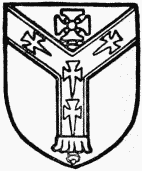
See of Canterbury. Azure the cross of the archbishop having its head or and its staff argent surmounted by the pall of a metropolitan argent having edges and fringes or and four crosses formy fitchy sable upon it.
These grantees were evidently trustees for Quarles, to whom they conveyed the manor in 1603. (fn. 77) It remained in his possession until 1606, in which year he conveyed it to William Turner, (fn. 78) from whom it passed, four years later, to Richard Infield or Innyngfield. (fn. 79) The latter in 1625 made a settlement on himself in tail, with contingent remainder to his brother and to his nephew Innyngfield Falconer, son of his sister Agnes. (fn. 80) He died in 1625 and was succeeded by his brother. (fn. 81) Henry and Agnes Falconer were seised of the manor in 1633. (fn. 82) It was conveyed by Falconer to Edward Payne in 1649, when the Park is mentioned as still existing. (fn. 83) Richard Payne, perhaps his son, was owner in 1669. (fn. 84) In 1697 Richard's son John Payne was holding it, (fn. 85) and in 1701 settled it on his intended wife, Anne Gage. (fn. 86)
Owing to a family dispute the manor was sold, and bought by John Smith, husband of Elizabeth Smith and grandson of John Payne by his first wife Blanche. (fn. 87) In 1743, apparently after the death of Ann and Elizabeth, John Smith, with his son and various trustees, conveyed the manor to Walter Harris, (fn. 88) from whom in 1765 it passed to Daniel Hailes. (fn. 89) The latter conveyed in 1779 to Thomas Dickson, who held it as late as 1807. (fn. 90) It was soon afterwards sold by him to Henry Kelsey, who died in 1827, and whose son, of Burstow Court Manor (q.v.), owned the estate in 1841 (fn. 91) and held it as a farm until 1887, when he died. It was bought from his family by Mr. Alfred Howard Lloyd in 1888. (fn. 92)
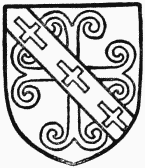
Kelsey. Gules a cross moline argent over all a bend azure with three plain crosses argent thereon.
Burstow Park is considered the manor-house of Burstow Court Manor, as well as of Burstow Park, but is probably not the most ancient manor-house of the former (see above). It is little more than a farmhouse. (fn. 93)
In 1328 John de Wysham received a grant of free warren in his demesne lands of Burstow and Horne, (fn. 94) and by inquisition taken in 1332, after his death, he was found to have been seised of 1 messuage, 160 acres of land, 6 acres of meadow, and 22s. rent in Burstow known as the manor of REDHALL near Burstow, which he held, jointly with Hawisia his wife, of John de Burstow. (fn. 95) His son John de Wysham, afterwards knighted, inherited the manor, and in 1370 granted it to John Pecche, citizen and alderman of London. (fn. 96) In 1379 John Pecche died seised of the manor, which he held of Richard Burstow by fealty, and by service of rendering thence yearly to the said Richard 42s., and by suit at his court of Burstow every three weeks. His son Sir William Pecche was his heir. (fn. 97)
The history of the manor during the next century is not apparent. It passed, however, out of the hands of the Pecches and became the property of the family of Welles. Mention is made in 1447 of a Henry Welles of Burstow. (fn. 98) Edward Welles was lord of the manor in 1595–6, (fn. 99) and it afterwards passed to John Welles, who held it in 1613. (fn. 100) In 1650 it was in the possession of Edward Payne the elder and Hannah his wife, (fn. 101) and it continued to be held by this family until the late 18th century. (fn. 102) Thomas Holles Payne, by his will, proved in May 1800, devised the manor of Redhall, including a capital messuage or mansion-house called Redhall, and a messuage called Cophall, to Sophia Elizabeth Beard and her heirs for ever. (fn. 103) The said messuages, &c., were in 1799, when the will was made, in the occupation of himself and Richard King, and mention is also made of two freehold tenements in Burstow which were included among the appurtenances of the manor. (fn. 104) Sophia Elizabeth Beard and her husband Richard Beard held the manor in 1801, (fn. 105) and Mrs. Beard was still lady of the manor in 1808. (fn. 106) It was occupied as a farm throughout the 19th century. (fn. 107) It is at present held by Mr. William Tebb. The house is surrounded by a broad moat inclosing a considerable area of ground.
The estate of SMALLFIELD in this parish belonged in the 16th and 17th centuries to the family of Bysshe, who were said to be descended from the de Burstows, lords of the manor of Burstow in the 13th and 14th centuries, through the marriage of an heiress of the latter family with John Bysshe. They said that the land had been given to their ancestor John de Burstow, who served under the Black Prince in the French wars, and who was promised a gift of some small field or piece of land in return for services rendered by him to Bartholomew Lord Burghersh. Land in Burstow called Crullinges was accordingly granted him, the name being changed to 'Smallfield' to meet the terms of the promise. (fn. 108) The house, Smallfield Place, was erected there apparently in the 17th century (fn. 109) by Edward Bysshe, a successful Chancery lawyer, the father of Sir Edward Bysshe. The latter, who was born there in 1615, was M.P. for Blechingley and also held the offices of Garter King-of-Arms and of Clarenceux King-of-Arms; he was knighted in 1661, (fn. 110) in which year he made additions to the house, which bore that date. Manning states that part of the house was pulled down, the remainder being occupied in his time as a farm, and owned by Isaac Martin Rebow, M.P., of Colchester, who died in 1781. (fn. 111) His daughter Mary Hester married General Francis Slater, who took the name of Rebow and owned Smallfield Place when Brayley wrote, in 1841. He died in 1845. By a second wife he left a daughter Mary, who married John Gurdon, who also took the name of Rebow. He died in 1870. His son was Hector John Gurdon Rebow, from whom Mr. William Leslie Moore, the present owner, bought Smallfield Place in 1898. (fn. 112)
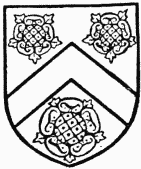
Bysshe. Or a cheveron between three roses gules.
The house, which had been only a farm, was converted again into a gentleman's house by Mr. W. Leslie Moore. It is an interesting house of local sandstone with a roof of Horsham slabs. With its three embattled and mullioned bay windows, its gabled porch, and the fireplaces, staircase, and panelling in the interior, it ranks, although but a fragment, among the more important remains of domestic architecture in Surrey. It has a good staircase and much old panelling in good preservation. (fn. 113) On it are the initials E.M.B. and the arms assumed by Bysshe, a cheveron between three roses. The old Bysshe coat was Ermine a chief battled gules with three leopards' heads or therein. (fn. 114) During the ownership of the Rebow family the house was occupied as a farm by a family named Hooker, one of whom used to manage the Burstow Harriers before they became the Burstow Foxhounds.
CHURCH
The church of ST. BARTHOLOMEW consists of a chancel 30 ft. by 14 ft. with a small vestry on the north side, a nave 38 ft. by 18 ft. with a south aisle 8 ft. 10 in. wide, a timber west tower, and a south porch.
The plan of the nave, and probably that of the chancel, dates from c. 1120, and the north and part of the west walls of the nave, with the west half of the north wall of the chancel, are for the most part of this time. Two original windows remain, one in the chancel and one in the nave; but nearly all the rest of the building, including the south aisle, belongs to the 15th century, and has been connected, though apparently on no direct evidence, with Archbishop Chicheley. The church was restored in 1884, the east wall of the aisle and the eastern quoins of the chancel being rebuilt.
The vestry and the south porch are modern additions. The east window of the chancel is of 15th-century date, and has three cinquefoiled lights under a flat drop arch with moulded label. The easternmost north window is a single trefoiled light, and the only other window in this wall is a narrow round-headed 12th-century light which now looks into the vestry.
Beneath the sill of the north-east window is a recess with two trefoiled openings separated by a mullion, and with moulded jambs and square head; it has served as a cupboard, and possibly also for the Easter sepulchre. West of it is a modern doorway to the vestry, and near the west end of the north wall, in an unusual position, is another aumbry set low in the wall, with rebated jambs and a square head.
The south-east window of the chancel is like the east window, but of two lights, and the other south window is of four lights of the same character. Near the east end of the south wall is a piscina with a small quatrefoiled basin and a chamfered shelf. The lower portion has plain chamfered jambs, but above the shelf they are moulded and the head is trefoiled, under a square lintel. It is of 15th-century date. Beneath the sill of the first window is a canopied seat which has moulded jambs and a very flat arched head.
Between the two south windows is a small 15th-century priest's doorway with a four-centred arch under a square head, and now blocked on the inside.
The vestry has a small single trefoiled east window, the jambs being of old stones re-used, but the head and sill are modern.
The 15th-century chancel arch has shafted and moulded jambs with octagonal moulded bases and capitals to the shafts. On either side of it are shallow trefoiled recesses to contain images over the nave altar, that on the south having a second recess below it, while in the south-east arcade of the nave is a piscina. At the north-east end of the north wall of the nave is an arched recess, common in this district, designed to give more room for the altar here.
The north-east window of the nave has two cinquefoiled lights under a flat head with a moulded label, and near the west end of the north wall is a window of four cinquefoiled lights under a square head with a moulded label, all but the foiled heads and the label being modern. Immediately to the east of it is a small blocked 12th-century window with a semicircular head, the western jamb of which must have been destroyed when the four-light window was inserted. Nothing of it can be seen on the inside. There is no trace of a doorway in this wall.
The south arcade is of three bays with columns formed of four attached shafts set square with the wall over, and not diagonally after the usual fashion; their moulded bases and capitals are single octagons, not following the plan of the shafts, the arrangement being unusual, but quite satisfactory in effect. The arches are four-centred and are moulded with a hollow casement between two hollow chamfers, and above the capitals at the springing level there are plain shields, and in a similar position on the south side of the east respond is a large carved head.
The east and west windows of the aisle are modern and have each two cinquefoiled lights, and the south-east window is like that in the north wall, of four cinquefoiled lights, of which only the heads are old; to the east of it is a piscina with chamfered jambs and four-centred head and a small quatrefoiled drain.
The south doorway is of 15th-century date and has moulded jambs and a two-centred arch under a square head, the spandrels being filled with quatrefoils.
At the west end of the nave is a modern Gothic tower arch, set within the lines of a four-centred arch evidently coeval with the south arcade. It was made to contain a deal screen of poor Gothic character, now set up in the west side of the tower. The tower is a very interesting piece of timber construction, probably of 15th-century date, the supporting beams and posts being very massive. As usual, the lower stage is wider than the upper, the main posts coming down within its lines, and being connected by heavy ground sills with a most picturesque effect. The ground stage must have been almost entirely dark before the narrow cinquefoiled windows were pierced in the north and south walls within recent years. The stairs to the belfry are in the north-west corner, and do not rise above the first floor; in the west wall is a wooden doorway with moulded jambs and a threecentred head with trefoiled spandrels. The upper part of the tower is covered with oak shingles lately renewed (1902), and has small angle pinnacles, and an octagonal shingled spire, on the east side of which a large flagstaff is set up. The fittings of the church, except the font, are of modern date, but under the tower is kept an old chest with an arched lid heavily strapped with iron, and doubtless of considerable age.
The font is of 15th-century date, octagonal with quatrefoil panels on each side, and leaf paterae at the base of the bowl.
There are six bells in the tower, the treble by Gillett and Johnson, 1906, and the second by the same founders, 1899, who at this date recast the other four bells, preserving their original inscriptions. The third was by John Daniell of London, c. 1450, inscribed, 'Sancte Thome ora pro nobis,' with Daniell's cross and stop, and the royal arms of England; the fourth had the three names 'Thos. Gelman, John Bhyss, and Wyllum Rofe'; the fifth was by William Mears, and the tenor by William Eldridge, 1681.

Plan of St. Bartholomew's Church, Burstow
The plate is as follows:—A silver cup of 1667; a paten probably belonging to it, but the hall-mark, if any, is almost obliterated. There is also a stand paten of 1899 and a flagon of 1898. There is a pocket Communion set of plated white metal.
The registers are contained in six books, the first having entries of baptisms, marriages, and burials from 1549 to 1600. This is a paper book in very good condition. The second book is of parchment, and contains all three entries from 1547 to 1685, and is a copy of the first with additions both at the beginning and end of the book. The third book has marriages and burials from 1685 to 1756 and baptisms from 1685 to 1797. The fourth has marriages on printed forms from 1757 to 1798, the fifth continues marriages from 1798 to 1812, and the sixth has entries of baptisms and burials from 1798 to 1812.
The churchyard is small, surrounded by tall trees, and on the east side is a modern wooden lych-gate.
Close to the church on the south, and at a lower level, stands the rectory, an old building of several periods, the middle being probably 16th-century work, and of timber construction. Additions were made by Flamsteed the astronomer, formerly rector here, and by several later rectors. To the west of the house is a rectangular site surrounded by a moat still full of water, on which ancient foundations are said to exist; it is at present a rose garden, and adds greatly to the beauty of the grounds of the vicarage.
ADVOWSON
The church of Burstow was probably built by the Archbishop of Canterbury on his land at Burstow, as it was always a peculiar of the see of Canterbury. (fn. 115) In 1121, when the earliest mention of the church occurs, Ralph, Archbishop of Canterbury, granted it to the Cluniac priory of St. Pancras at Lewes. (fn. 116) In the confirmation of its charters made to this house from 1129 to 1171 it appears as holding Burstow Church. (fn. 117) It is not apparent how long the monks continued to do so, but it is possible that the archbishop reclaimed it towards the end of the 13th century, as from 1286 onwards the alien priory of Lewes was liable to have its possessions seized when there was war with France. (fn. 118) Presentation was made to Burstow by the king in the 14th century during voidance of the see of Canterbury. (fn. 119) The church came finally into possession of the Crown in 1536, being given up by the archbishop with his manor of Burstow Park. (fn. 120) Except during the time of the Commonwealth, when the right of presentation was vested in the Lord Protector, (fn. 121) the patronage has since that time remained in the Crown, presentation being now made by the Lord Chancellor. (fn. 122) The living ceased to be a peculiar to the see of Canterbury in 1851, when it was united to Winchester. By the rearrangement of dioceses in 1878 it was joined to Rochester. One eminent man, John Flamsteed, the famous astronomer, was rector of Burstow from 1684 to 31 December 1719, when he died.
CHARITIES
Smith's Charity is distributed as in other Surrey parishes.
In 1684 Ralph Cooke, rector of Burstow, left money to buy large upper coats for a widower and a widow yearly.
In 1718 John Flamsteed, rector and Astronomer Royal, left money to buy new coats for two poor Christian people.
In 1728 Mrs. Margaret Flamsteed, widow of the rector, left money for clothing for two poor women.
